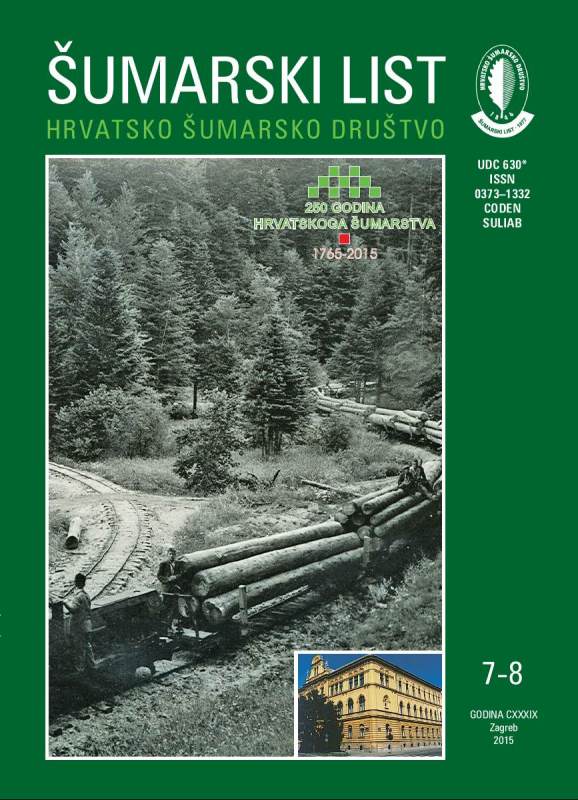
broj: 7-8/2015
pdf (9,95 MB) |
|
||||||||||||||
| RIJEČ UREDNIŠTVA | ||
| Uredništvo | ||
| WHAT CHARACTERISTICS SHOULD FORESTRY STAFF POSSES? pdf HR EN | 309 | |
| IZVORNI ZNANSTVENI ČLANCI | ||
| Ivica Papa, Tibor Pentek, Kruno Lepoglavec, Hrvoje Nevečerel, Tomislav Poršinsky, Željko Tomašić | UDK 630*383+686 (001) | |
| METHODOLOGY OF DEVELOPMENT OF DETAILED PRIMARY FOREST TRAFFIC INFRASTRUCTURE REGISTER AS THE BASIS FOR FOREST ROADS MAINTENANCE PLANNING AND OPTIMIZATION pdf HR EN | 311 | |
| Željko Zgrablić, Zdenko Tkalčec, Armin Mešić, Hrvoje Marjanović, Danko Diminić | UDK 630*443 (001) | |
| DO ECTOMYCORRHIZAL FUNGI REDUCE AUSTRIAN PINE (Pinus nigra J. F. Arnold) SUSCEPTIBILITY TO Sphaeropsis sapinea (FR.) Dyko et Sutton INFECTION? pdf HR EN | 329 | |
| Ida Katičić Bogdan, Karla Švorinić, Saša Bogdan, Davorin Kajba | UDK630*164+165 (001) | |
| GENERATIVE AND VEGETATIVE ACTIVITY OF WILD CHERRY (Prunus avium L.) IN A CLONAL SEED ORCHARD pdf HR EN | 339 | |
| Janez Krč, Uroš Vranešič, Boštjan Košir | UDK 630*323+363 (001) | |
| COMPARISON OF MECHANIZED AND MOTOR-MANUAL CUTTING OPERATION IN MIXED STANDS OF SOUTHERN SLOVENIA pdf HR EN | 351 | |
| Korhan Enez, Burak Aricak, Temel Sariyildiz | UDK 630*312+285 (001) | |
| EFFECTS OF HARVESTING ACTIVITIES ON LITTER DECOMPOSITION RATES OF SCOTS PINE, TROJAN FIR, AND SWEET CHESTNUT pdf HR EN | 361 | |
| Summary This study aims to investigate the possible effects of harvesting activities on litter decomposition in micro ecologic areas belonging to 3 different species (Trojan fir (Abies nordmanniana subsp. Equi-trojani (Aschers & Sint. ex. Boiss) Coode & Cullen), scots pine (Pinus sylvestris L.) and sweet chestnut (Castanea sativa Miller)). To this end, litter decomposition experiments were carried out on these three species. The litter decomposition specimens were placed on their own stands where there were harvesting activities in previous years and in neighboring stands where there were no harvesting activities for control purposes. Theses micro ecologic areas are nonharvesting activity areas (control) (C), intra-forest skidding roads (Skidding road) (SR), under logging residues (Logging residue) (LR) and areas with a 20% slope and top-soil damaged during harvesting activities and scalped mineral soil (SMS). The decomposition processes were observed for 18 months, mass change values were calculated every six months and their mass loss and decomposition values were calculated. At the end of eighteen months, it was seen that the effects of intra-forest activities on litter decomposition showed differences among micro ecologic areas. According to the study results, forest harvesting activities (C, SR, LR and SMS) affect litter decomposition in various micro ecologic areas that occur in the remaining stand in great extent. As well as this, it is seen that the effect of forest harvesting activities on the litter decomposition is not in the same direction for every species. This study revealed that on micro ecologic areas decomposition sorting in ascending order was LR > C > SMS > SR for scots pine needles, LR = SR > C > SMS for Trojan fir needles, and C > SR > LR > SMS for sweet chestnut leaves. It has been concluded that forest harvesting activities influenced litter decomposition rates significantly. Key words: litter mass loss; logging; skidding road; scalping; logging residue | ||
| Burak Aricak, Alper Bulut, Arif Ogˇuz Altunel, Oytun Emre Sakici | UDK 630*537+425 (001) | |
| ESTIMATING ABOVE-GROUND CARBON BIOMASS USING SATELLITE IMAGE REFLECTION VALUES: A CASE STUDY IN CAMYAZI FOREST DIRECTORATE, TURKEY pdf HR EN | 369 | |


